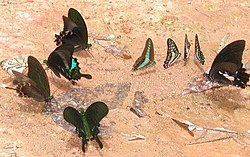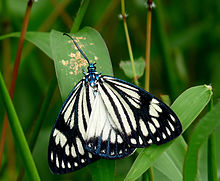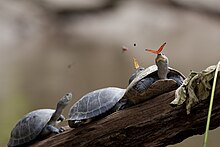Mud-puddling

Mud-puddling, or simply puddling, is behaviour most conspicuous in butterflies, but occurs in other animals as well, mainly insects; they seek out certain moist substances such as rotting plant matter, mud and carrion and they suck up the fluid. Where the conditions are suitable conspicuous insects such as butterflies commonly form aggregations on wet soil, dung or carrion.[1] From the fluids they obtain nutrients such as salts and amino acids that play various roles in their physiology, ethology and ecology.[2][3] This behaviour also has been seen in some other insects, notably the leafhoppers, e.g. the potato leafhopper, Empoasca fabae.[4]
Lepidoptera (butterflies and moths) are diverse in their strategies to gather liquid nutrients. Typically, mud-puddling behavior takes place on wet soil. But even sweat on human skin may be attractive to butterflies such as species of Halpe.[5][6] More unusual sources include blood and tears. Again, similar behaviour is not limited to the Lepidoptera, and for example, the various species of bees commonly called sweat bees are attracted to various kinds of sweat and tears, including that of humans, and other bee species have been recorded as doing so to various degrees.[7][8]
In many species puddling behaviour is restricted to males, and the presence of an assembly of butterflies on the ground acts on Battus philenor for example, as a stimulus to join the presumptive mud-puddling flock.[1]
On soil

In tropical India this phenomenon is mostly seen in the post-monsoon season. The groups generally include several species, particularly members of the families Papilionidae and Pieridae.[9]
Males seem to benefit from the sodium uptake through mud-puddling behaviour with an increase in reproductive success. The collected sodium and amino acids are often transferred to the female with the spermatophore during mating as a nuptial gift. This nutrition also enhances the survival rate of the eggs.[10][11][12]
When puddling, many butterflies and moths pump fluid through the digestive tract and release fluid from their anus. In some, such as the male notodontid Gluphisia septentrionis, this is released in forced anal jets at 3 second intervals. Fluid of up to 600 times the body mass may pass through and males have a much longer ileum (anterior hindgut) than non-puddling females.[13]
Other sources of liquid nutrients

Some Orthoptera – e.g. the Yellow-spined Bamboo Locust (Ceracris kiangsu) – are attracted to human urine, specifically to the sodium and ammonium ions in it.[14] Those Lepidoptera that are attracted to dung (e.g. Zeuxidia spp.) or carrion seem to be prefer ammonium ions rather than sodium.[15] In rotting, the tissues of fruits release sugars and other organic compounds such as alcohols that result from the metabolic processes of decay organisms; butterflies mainly utilise such substances as metabolic fuel.[16]
In Borneo lowland rain forest, numerous species of butterflies regularly visit decaying fruit to drink. This behavior is mainly opportunistic, though some are highly attracted to old fruit, notably Satyrinae (e.g. Neorina lowii) and Limenitidinae such as Bassarona dunya.[6]
Carrion is usually more intentionally utilized. Carrion-feeders seem to represent a different feeding guild from "classical" mud-puddlers and fruit-feeders. They include diverse taxa, e.g. brush-footed butterflies such as Cirrochroa emalea of the Nymphalinae or the Tawny Rajah (Charaxes bernardus) of the Charaxinae, as well as gossamer-winged butterflies like Curetis tagalica of the Curetinae or the Common Imperial (Cheritra freja) of the Theclinae.[6]


Carrion-feeding has evolved independently in several lineages. Specialist carrion-feeders may even have the ability to smell out and home in on rotting meat over hundreds of meters. In the Bornean Charaxinae, Specialist (Charaxes bernardus) or opportunistic (some other Charaxes and Polyura) tend to have a markedly larger bulk and smaller wings, making them more dashing, maneuvrable flyers than fruit specialists like Prothoe franck and opportunistic fruit visitors such as Charaxes durnfordi. Other butterflies like most Pieridae, Papilionidae and Morphinae are rarely if ever seen on carrion, dung and rotting fruit, though they may be avid mud-puddlers in the strict sense. Altogether, the Nymphalidae show the highest variety of nutrient-gathering strategies among the butterflies; the Limenitidinae have numerous mud-puddlers that also frequently visit dung but avoid fruits and carrion (namely the genus Limenitis),[6] and some which are attracted to any pungent substance.[17]
Certain moths, mainly of the subfamily Calpinae, are somewhat notorious for their blood- and tear-drinking habits. Hemiceratoides hieroglyphica of Madagascar has been noted to visit and suck tears by inserting their proboscis into the closed eyelids of roosting birds.[18] Other cases of moths drinking human tears have been reported from Thailand.[19] Some species of the genus Calyptra are called "vampire moths" as they suck blood from sleeping vertebrates, including humans. Ophthalmotropy (eye-attraction) and lachryphagy (tear drinking) occur in a number of unrelated moths that visit mammals. Mecistoptera griseifusa is a notable example.[19]
References
Notes
- ^ a b Sculley, C.E. & Boggs, C.L. (1996): Mating systems and sexual division of foraging effort affect puddling behaviour by butterflies. Ecological Entomology 21(2): 193-197. PDF fulltext
- ^ Boggs, CL & LA Jackson (1991) Mud puddling by butterflies is not a simple matter Ecological Entomology 16(1):123-127 doi:10.1111/j.1365-2311.1991.tb00199.x PDF fulltext
- ^ Beck, J.; Mühlenberg, E. & Fiedler, K. (1999): Mud-puddling behavior in tropical butterflies: In search of proteins or minerals? Oecologia 119(1): 140–148. doi:10.1007/s004420050770 (HTML abstract) PDF fulltext
- ^ Adler, P.H. (1982): Nocturnal occurrences of leafhoppers (Homoptera: Cicadellidae) at soil. Journal of the Kansas Entomological Society 55(1): 73–74. HTML abstract
- ^ Collenette, C.L. (1934): On the sexes of some South American moths attracted to light, human perspiration and damp sand. Entomologist 102: 769-791.[verification needed]-- Volume 67 pp.81-87
- ^ a b c d Hamer, K.C.; Hill, J.K.; Benedick, S.; Mustaffa, N.; Chey, V.K. & Maryati, M. (2006): Diversity and ecology of carrion- and fruit-feeding butterflies in Bornean rain forest. Journal of Tropical Ecology 22(1): 25–33. doi:10.1017/S0266467405002750 (HTML abstract)
- ^ Charles Leonard Hogue (1993). Latin American Insects and Entomology. University of California Press. pp. 457–. ISBN 978-0-520-07849-9.
- ^ Brian Morris (2004). Insects and Human Life. Berg. pp. 280–. ISBN 978-1-84520-075-6.
- ^ Sreekumar, P.G. & Balakrishnan, M. (2001): Habitat and altitude preferences of butterflies in Aralam Wildlife Sanctuary, Kerala. Tropical Ecology 42(2): 277-281. PDF fulltext
- ^ Pivnik, K. & McNeil, J.N. (1987): Puddling in butterflies: sodium affects reproductive success in Thymelicus lineola. Physiological Entomology 12(4): 461–472.
- ^ * Medley S.R. & Eisner, T. (1996): Sodium: a male nuptial gift to its offspring. PNAS 93(2): 809–813. PDF fulltext
- ^ Molleman, F.; Zwaan, B.J. & Brakefield, P.M. (2004): The effect of male sodium diet and mating history on female reproduction in the puddling squinting bush brown Bicyclus anynana (Lepidoptera). Behavioral Ecology and Sociobiology 56(4): 404–411. doi:10.1007/s00265-004-0789-2 (HTML abstract)
- ^ Scott R. Smedley in Resh, V. H. & R. T. Cardé (Editors) 2003. Encyclopedia of Insects. Academic Press.
- ^ Shen, Ke; Wang, Hao-Jie; Shao, Lin; Xiao, Kai; Shu, Jin-Ping; Xu, Tian-Sen & Li, Guo-Qing (2009): Mud-puddling in the yellow-spined bamboo locust, Ceracris kiangsu (Oedipodidae: Orthoptera): Does it detect and prefer salts or nitrogenous compounds from human urine? Journal of Insect Physiology 55(1): 78-84. doi:10.1016/j.jinsphys.2008.10.011 (HTML abstract)
- ^ * Erhardt, A. & Rusterholz, H.P. (1998): Do Peacock butterflies (Inachis io) detect and prefer nectar amino acids and other nitrogenous compounds? Oecologia 117(4): 536-542. doi:10.1007/s004420050690 (HTML abstract)
- ^ DeVries, P.J. & Walla, T.R. (2001): Species diversity and community structure in neotropical fruit-feeding butterflies. Biol. J. Linn. Soc. 74: 1–15. PDF fulltext
- ^ Several Apatura species are famous among lepidopterologists for being easily attracted with stinking cheese.
- ^ * Hilgartner, R.; Raoilison, Mamisolo; Büttiker, Willhelm; Lees, David C. & Krenn, Harald W. (2007): Malagasy birds as hosts for eye-frequenting moths. Biol. Lett. 3(2): 117–120. doi:10.1098/rsbl.2006.0581 (HTML abstract) PDF fulltext
- ^ a b Bänziger, H. (1992): Remarkable new cases of moths drinking human tears in Thailand (Lepidoptera: Thyatiridae, Sphingidae, Notodontidae). Natural History Bulletin of the Siam Society 40: 101–102. PDF fulltext
Sources
- Locke, B.; Otis, Gard W.; McKenzie, Nicole G.; Cheung, D.; MacLeod, E.C. & Kwoon, A. (2003): Mud puddling Papilio and Battus swallowtail butterflies (Papilionidae) have different mechanisms for social facilitation. 2003 Entomological Society of America Annual Meeting Poster Presentation D0541. HTML abstract
